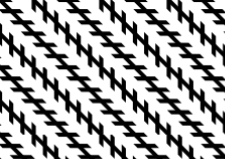Difference between revisions of "Zollner illusion" - New World Encyclopedia
(Copied from wikipedia) |
(fixed) |
||
| Line 6: | Line 6: | ||
[[Image:Zollner_illusion.svg|thumb|right|225px|'''Zollner illusion''']] | [[Image:Zollner_illusion.svg|thumb|right|225px|'''Zollner illusion''']] | ||
| − | The '''Zollner illusion''' is a classic [[optical illusion]] named after its discoverer, German astrophysicist [[Johann Karl Friedrich Zöllner]]. In | + | The '''Zollner illusion''' is a classic [[optical illusion]] named after its discoverer, German astrophysicist [[Johann Karl Friedrich Zöllner]]. In 1860, Zöllner sent his discovery in a letter to physicist and scholar J. C. Poggendorff, editor of ''[[Annalen der Physik|Annalen der Physik und Chemie]]'', who subsequently discovered the related [[Poggendorff illusion]]. |
In this figure the black lines seem to be unparallel, but in reality they are parallel. The shorter lines are on an angle to the longer lines. This angle helps to create the impression that one end of the longer lines is nearer to us than the other end. This is very similar to the way the [[Wundt illusion]] appears. It may be that the ''Zollner illusion'' is caused by this impression of depth. | In this figure the black lines seem to be unparallel, but in reality they are parallel. The shorter lines are on an angle to the longer lines. This angle helps to create the impression that one end of the longer lines is nearer to us than the other end. This is very similar to the way the [[Wundt illusion]] appears. It may be that the ''Zollner illusion'' is caused by this impression of depth. | ||
| Line 19: | Line 19: | ||
==External links== | ==External links== | ||
| − | + | * [http://www.ritsumei.ac.jp/~akitaoka/zollnere.html Zöllner illusion] at Akiyoshi Kitayoka's illusion pages | |
{{Credits|Zollner_illusion|115273991|}} | {{Credits|Zollner_illusion|115273991|}} | ||
Revision as of 16:03, 14 September 2007
The Zollner illusion is a classic optical illusion named after its discoverer, German astrophysicist Johann Karl Friedrich Zöllner. In 1860, Zöllner sent his discovery in a letter to physicist and scholar J. C. Poggendorff, editor of Annalen der Physik und Chemie, who subsequently discovered the related Poggendorff illusion.
In this figure the black lines seem to be unparallel, but in reality they are parallel. The shorter lines are on an angle to the longer lines. This angle helps to create the impression that one end of the longer lines is nearer to us than the other end. This is very similar to the way the Wundt illusion appears. It may be that the Zollner illusion is caused by this impression of depth.
It is interesting to see what happens when the colours in this illusion are changed. If the illusion is printed in green on a red background and the red and green are equally bright, the illusion disappears.
This illusion is similar to the Hering illusion, the Poggendorff illusion and the Mueller-Lyer illusion. All these illusions demonstrate how lines can seem to be distorted by their background.
External links
- Zöllner illusion at Akiyoshi Kitayoka's illusion pages
Credits
New World Encyclopedia writers and editors rewrote and completed the Wikipedia article in accordance with New World Encyclopedia standards. This article abides by terms of the Creative Commons CC-by-sa 3.0 License (CC-by-sa), which may be used and disseminated with proper attribution. Credit is due under the terms of this license that can reference both the New World Encyclopedia contributors and the selfless volunteer contributors of the Wikimedia Foundation. To cite this article click here for a list of acceptable citing formats.The history of earlier contributions by wikipedians is accessible to researchers here:
The history of this article since it was imported to New World Encyclopedia:
Note: Some restrictions may apply to use of individual images which are separately licensed.
